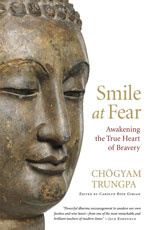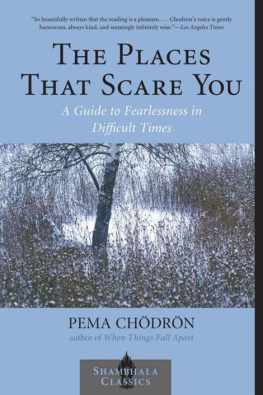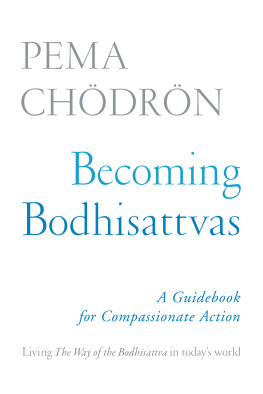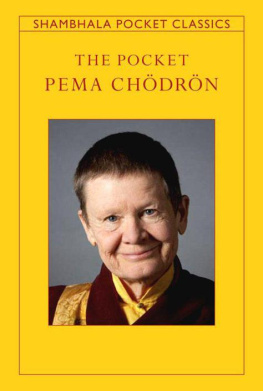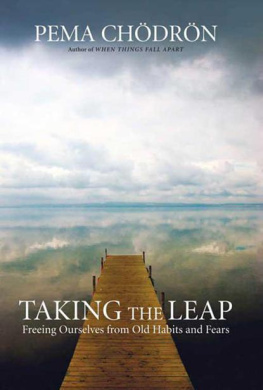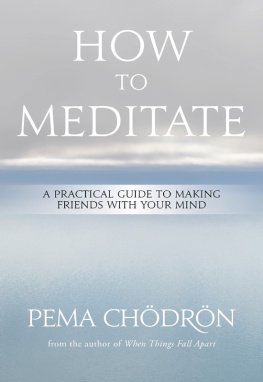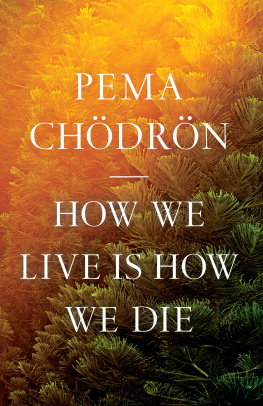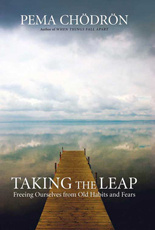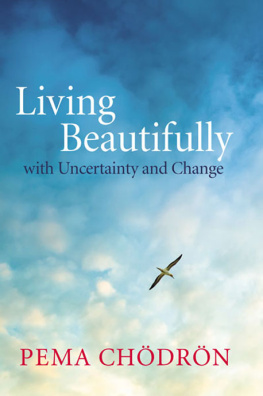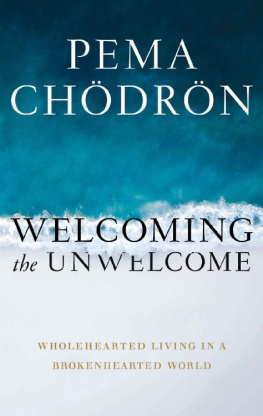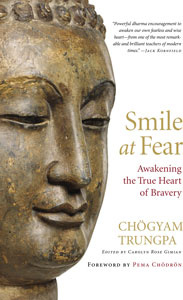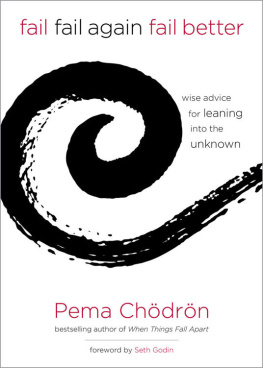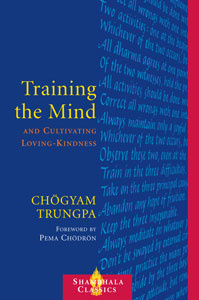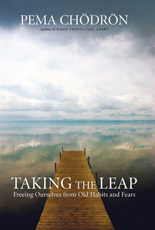S HAMBHALA P UBLICATIONS, I NC .
Horticultural Hall
300 Massachusetts Avenue
Boston, Massachusetts 02115
www.shambhala.com
1997 by Pema Chdrn
The Sdhana of Mahmudr 1968, 1976 by Chgyam Trungpa, 1990 by Diana J. Mukpo. Used by permission of Diana J. Mukpo and the Nalanda Translation Committee.
The authors proceeds from this book will be donated to Gampo Abbey, Pleasant Bay, Nova Scotia, Canada B0E 2P0.
All rights reserved.
No part of this book may be reproduced in any form or by any means, electronic or mechanical, including photocopying, recording, or by any information storage and retrieval system, without permission in writing from the publisher.
The Library of Congress catalogues the hardcover edition of this book as follows:
Chdrn, Pema.
When things fall apart: heart advice for difficult times/
Pema Chdrn.
p. cm.
eISBN 978-0-8348-2100-2
ISBN 1-57062-160-8
ISBN 1-57062-344-9
ISBN 1-57062-969-2
1. Religious lifeBuddhism. I. Title.
BQ5410.C434 1997 96-9509
394-3 444dc20 CIP
To Sakyong Mipham,
with devotion, love, and gratitude
CONTENTS
ACKNOWLEDGMENTS
My sincere gratitude to Lynne Van de Bunte, who not only preserved the tapes that make up the talks in the book but also spent many hours finding the following people to transcribe them: my thanks to Heidi Utz, Rex Washburn, Ginny Davies, and Aileen and Bill Fell (who also got all the talks on one computer), and also to Lynne herself, who transcribed the tapes that were so ancient, no one else could figure out what was being said. Finally, a very special thank-you to my friend and editor Emily Hilburn Sell, who took a carton of unedited talks and transformed them into this book. Without her talent, hard work, and loving dedication, I would never have published anything. I feel fortunate that we can continue to work together.
INTRODUCTION
I N 1995 I took a sabbatical. For twelve months I essentially did nothing. It was the most spiritually inspiring time of my life. Pretty much all I did was relax. I read and hiked and slept. I cooked and ate, meditated and wrote. I had no schedule, no agenda, and no shoulds. A lot got digested during this completely open, uncharted time. For one thing, I began to read slowly through two cardboard boxes of very raw, unedited transcriptions of talks I had given from 1987 to 1994. Unlike the dathun talks that make up The Wisdom of No Escape and the lojong teachings that make up Start Where You Are, these talks seemed to have no unifying thread. Now and then I would look at a few transcripts. I found them everything from pedantic to delightful. It was both interesting and embarrassing to be faced with such a profusion of my own words. Gradually, as I read more, I began to see that in some way, no matter what subject I had chosen, what country I was in, or what year it was, I had taught endlessly about the same things: the great need for maitri (loving-kindness toward oneself), and developing from that the awakening of a fearlessly compassionate attitude toward our own pain and that of others. It seemed to me that the view behind every single talk was that we could step into uncharted territory and relax with the groundlessness of our situation. The other underlying theme was dissolving the dualistic tension between us and them, this and that, good and bad, by inviting in what we usually avoid. My teacher, Chgyam Trungpa Rinpoche, described this as leaning into the sharp points. It occurred to me that for all those seven years, Id been simply trying to digest and communicate the helpful and very gutsy instructions that Trungpa Rinpoche gave his students.
As I delved into the boxes, I could see that I still had a long way to go before fully appreciating what I had been taught. I also saw that by putting Rinpoches advice into practice as well as I could, and by attempting to share this experience of a students path with others, I had found a kind of fundamental happiness and contentment that Id never known before. It made me laugh to see that, just as I had so often said, making friends with our own demons and their accompanying insecurity leads to a very simple, understated relaxation and joy.
About halfway through the year, my editor, Emily Hilburn Sell, happened to ask me if I had any more talks that might be usable for a third book. I sent her the cardboard boxes. She read through the transcripts and felt inspired to tell Shambhala Publications, We have another book.
Over the next six months, Emily sifted and shifted and deleted and edited, and I had the luxury to work further on each chapter to my hearts content. When I wasnt resting or looking at the ocean or walking in the hills, I would get totally absorbed by these talks. Rinpoche once gave me the advice Relax and write. At the time it didnt seem like Id ever do either of these things, but years later, here I was following his instructions.
The result of this collaboration with Emily and my year of doing nothing is this book.
May it encourage you to settle down with your life and take these teachings on honesty, kindness, and bravery to heart. If your life is chaotic and stressful, theres plenty of advice here for you. If youre in transition, suffering from loss, or just fundamentally restless, these teachings are tailor made. The main point is that we all need to be reminded and encouraged to relax with whatever arises and bring whatever we encounter to the path.
In putting these instructions into practice, we join a long lineage of teachers and students who have made the buddha dharma relevant to the ups and downs of their ordinary lives. Just as they made friends with their egos and discovered wisdom mind, so can we.
I thank the Vidyadhara, the Venerable Chgyam Trungpa Rinpoche, for totally committing his life to the dharma and for being so eager to transmit its essence to the people of the West. May the inspiration I received from him be contagious. May we, like him, lead the life of a bodhisattva, and may we not forget his proclamation that Chaos should be regarded as extremely good news.
P EMA C HDRN
Gampo Abbey
Pleasant Bay, Nova Scotia, 1996
Intimacy with Fear
Fear is a natural reaction to moving closer to the truth.
E MBARKING on the spiritual journey is like getting into a very small boat and setting out on the ocean to search for unknown lands. With wholehearted practice comes inspiration, but sooner or later we will also encounter fear. For all we know, when we get to the horizon, we are going to drop off the edge of the world. Like all explorers, we are drawn to discover whats waiting out there without knowing yet if we have the courage to face it.
If we become interested in Buddhism and decide to find out what it has to offer, well soon discover that there are different slants on how we can proceed. With insight meditation we begin practicing mindfulness, being fully present with all our activities and thoughts. With Zen practice we hear teachings on emptiness and are challenged to connect with the open, unbounded clarity of mind. The vajrayana teachings introduce us to the notion of working with the energy of all situations, seeing whatever arises as inseparable from the awakened state. Any of these approaches might hook us and fuel our enthusiasm to explore further, but if we want to go beneath the surface and practice without hesitation, it is inevitable that at some point we will experience fear.
Fear is a universal experience. Even the smallest insect feels it. We wade in the tidal pools and put our finger near the soft, open bodies of sea anemones and they close up. Everything spontaneously does that. Its not a terrible thing that we feel fear when faced with the unknown. It is part of being alive, something we all share. We react against the possibility of loneliness, of death, of not having anything to hold on to. Fear is a natural reaction to moving closer to the truth.
Next page
